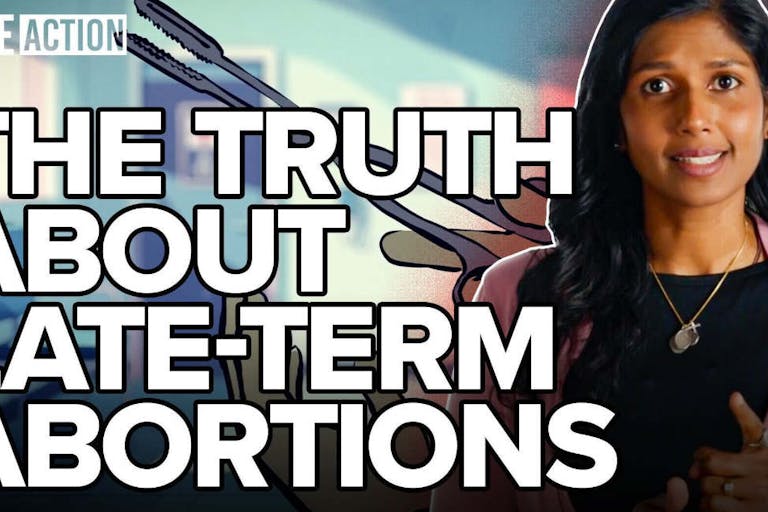
Vietnamese Catholics widen support for pregnant mothers
Angeline Tan
·
New Live Action ‘Pro-Life Replies’ video debunks myths about late-term abortions
A new Live Action video delves into the issue of late-term abortions, and why women get them.
The latest addition to Live Action’s “Pro-Life Replies” series features board-certified OB-GYN Dr. Monique Ruberu, who discusses whether late-term abortions are truly only committed out of tragic medical necessity, or if that idea is propaganda.

Late-term abortions are typically described as exceedingly rare, and only committed in instances of serious medical necessity.
The abortion industry insists that late-term abortions are committed if the mother’s life is at risk, or if the preborn child has a serious fatal anomaly.
In reality, tens of thousands of late-term abortions are committed every year.
Women undergo late-term abortions for largely the same reasons they seek out earlier abortions.
Ruberu acknowledged that late-term abortions — typically defined as abortions taking place after the first trimester, or after 15 weeks of pregnancy — are among the minority of abortions. Yet they still occur much more often than the abortion industry would like people to believe.
“According to the pro-abortion Guttmacher Institute, there have been just under 1 million abortions every year for the last decade,” she explained. “And more than that in decades before. Guttmacher estimates that between 6.3% and 7.4% of all U.S. abortions are obtained at or after 15 weeks of pregnancy. Using their data from 2023, the math comes out to anywhere between 65,331 and 76,738 abortions that year. When we’re talking about a million abortions per year, 1% of that is still 10,000 abortions per year. 27 abortions per day.”
She added, “That’s a whole classroom of children.”
Ruberu also pointed out that other causes of death are not minimized the way late-term abortions are.
“In 2017, 2,813,503 deaths were reported in the United States. 1.4% of those were firearm-related. 1.3% of those were alcohol-induced causes. 1.7% of those were suicides,” she said. “But nobody is trying to minimize the significance of gun violence, are they? Even if you could consider it rare, getting killed by something rare doesn’t make you any less dead. The point is, you don’t care if it’s rare if it happens to you. No loss of life should ever be treated as insignificant.”
When people speak about late-term abortions and why they are necessary, what is discussed much less often is what late-term abortions actually entail. In the video, Ruberu — a board-certified OB/GYN — explained.
“In a second-trimester D&E abortion, the child is dismembered with forceps,” she said. “In a third-trimester induction abortion, the child is lethally injected with poison, either in the amniotic fluid, or in the heart, or in the head.”

Article continues below
Dear Reader,
In 2026, Live Action is heading straight where the battle is fiercest: college campuses.
We have a bold initiative to establish 100 Live Action campus chapters within the next year, and your partnership will make it a success!
Your support today will help train and equip young leaders, bring Live Action’s educational content into academic environments, host on-campus events and debates, and empower students to challenge the pro-abortion status quo with truth and compassion.
Invest in pro-life grassroots outreach and cultural formation with your DOUBLED year-end gift!
This is the targeted, intentional killing of a preborn child. And as Ruberu said, it is not medically necessary. In a true medical emergency, there are other options that do not involve directly and intentionally killing the child.
“If the woman’s life is at risk, the doctor can carry out an early delivery and work to save both the mother and the child. Children have survived outside the womb as early as 21 weeks. They don’t always survive early delivery, but at least we’re giving them a chance,” she said, adding:
And this is completely different than intentionally killing the child by dismemberment or lethal injection. What if the baby is diagnosed with a condition that is deemed incompatible with life? Again, the solution is never to intentionally kill the child.
We deliver the child and give him or her every chance at life. If it becomes certain that the child will not survive, then we give the baby perinatal hospice and palliative care, relieving the suffering of the baby as much as possible, and letting him or her die in the loving arms of the parents, not under the cruel instruments of the abortionist.
So why are women actually getting late-term abortions? The reality is, it rarely is due to some form of medical necessity.
“A 2013 study published by the pro-abortion Guttmacher Institute said, data suggests that most women seeking later terminations are not doing so for reasons of fetal anomaly or life endangerment,” Ruberu said, going on to detail the reasons:
The abortion lobby’s own research shows that women who obtain late abortion cite similar reasons for seeking an abortion as those who do so earlier in pregnancy. Those reasons typically include financial concerns, relationship problems, educational goals, and so on.
Guttmacher also stated in 2005 that most late-term abortions are not medically necessary. That report revealed that at least 69% of abortions at 13 weeks and beyond were elective, meaning that the mother chose to abort her baby after 13 weeks without any indication of medical necessity. Abortion training lecturers from UCSF claim women who abort later in pregnancy do not do so primarily for health reasons. Abortion staffers testified to having witnessed late-term abortions committed for non-medical reasons.
Most Americans do not support late-term abortions, which is why the abortion industry has to work so hard to make them seem justifiable. But the reality is much more tragic and violent than what abortion activists would like people to believe.
Live Action News is pro-life news and commentary from a pro-life perspective.
Contact editor@liveaction.org for questions, corrections, or if you are seeking permission to reprint any Live Action News content.
Guest Articles: To submit a guest article to Live Action News, email editor@liveaction.org with an attached Word document of 800-1000 words. Please also attach any photos relevant to your submission if applicable. If your submission is accepted for publication, you will be notified within three weeks. Guest articles are not compensated (see our Open License Agreement). Thank you for your interest in Live Action News!

Angeline Tan
·
Analysis
Cassy Cooke
·
Analysis
Cassy Cooke
·
Analysis
Cassy Cooke
·
Analysis
Cassy Cooke
·
Analysis
Nancy Flanders
·
Analysis
Cassy Cooke
·
Analysis
Cassy Cooke
·
Analysis
Cassy Cooke
·
Analysis
Cassy Cooke
·
International
Cassy Cooke
·